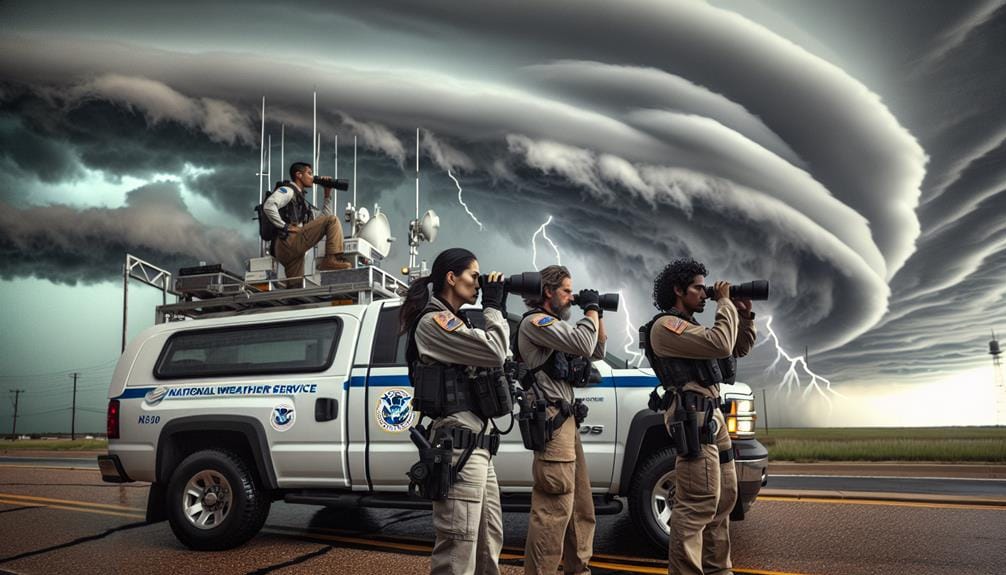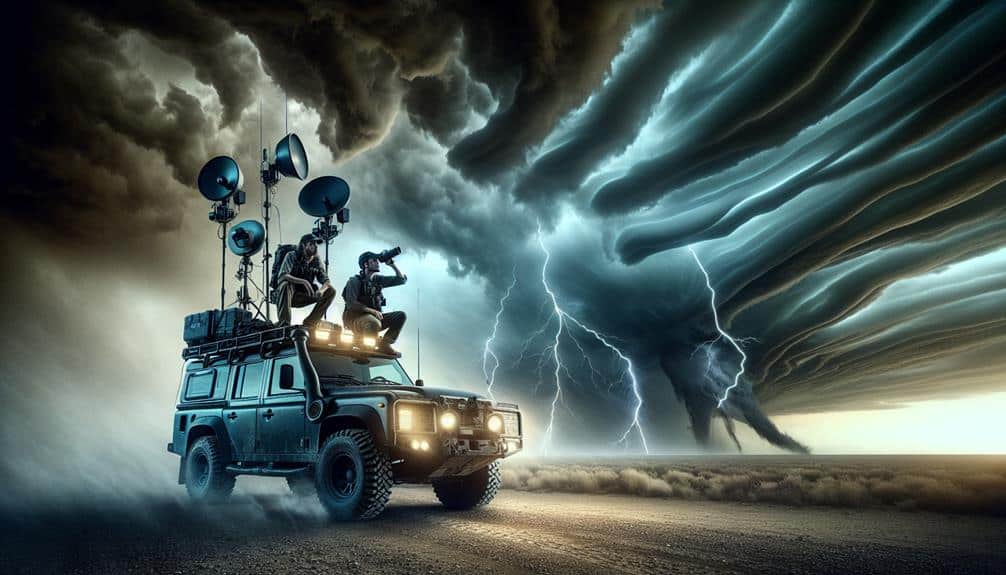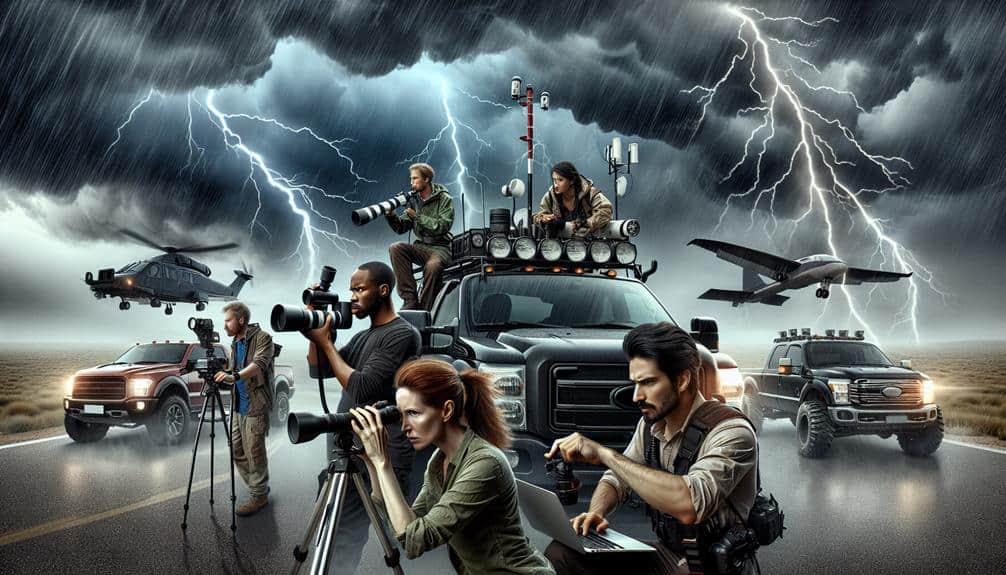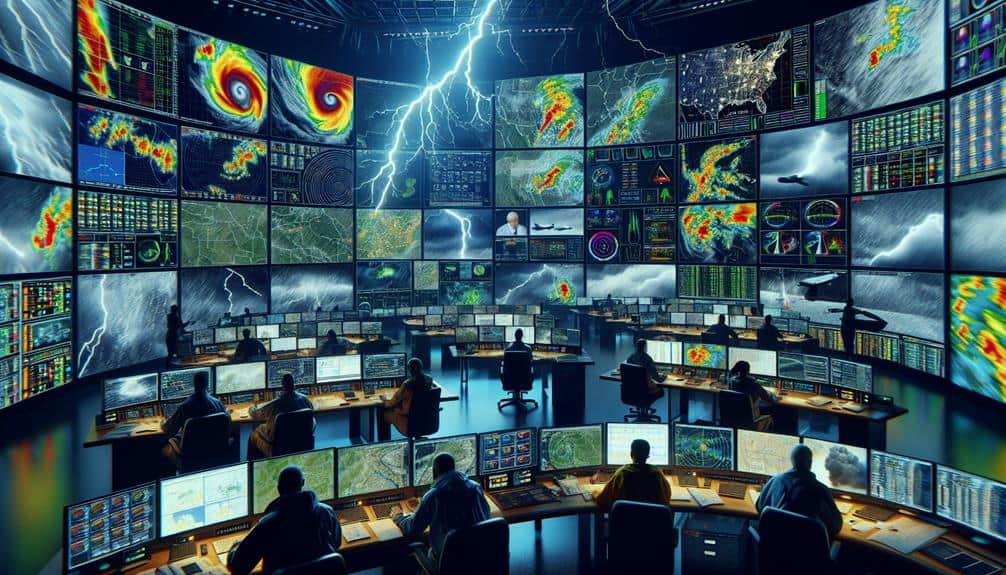We recommend five exceptional storm chaser training programs. Skywarn Spotter Training is ideal for honing observational accuracy and safety skills. For advanced meteorological prowess, Storm Spotter Certification is a thorough choice. MetEd Weather Courses offer specialized modules on atmospheric dynamics using data-driven methods. College Meteorology Programs provide in-depth academic training enriched with practical fieldwork. Finally, the National Weather Service Training emphasizes real-time data gathering and state-of-the-art forecasting techniques. Each program enhances our ability to navigate severe weather safely and effectively. Explore these options to master storm chasing with scientific precision and expertise.
Key Points
- Skywarn Spotter Training: Focuses on safety, storm tracking, and accurate severe weather reporting.
- Storm Spotter Certification: Covers advanced meteorological concepts, radar data, and emergency response planning.
- MetEd Weather Courses: Offers specialized meteorological training with real-world case studies and practical applications.
- College Meteorology Programs: Provides academic training in atmospheric science with fieldwork and advanced tools for storm chasing.
Skywarn Spotter Training
Skywarn Spotter Training equips participants with the skills to accurately observe and report severe weather phenomena to the National Weather Service. As aspiring storm chasers, we grasp the adrenaline rush that comes with tracking powerful storms, but our primary focus is always on safety and accuracy. This program teaches us to identify key weather patterns, such as wall clouds, funnel clouds, and tornadoes, using scientific precision and data-driven methods.
During training, we explore the technical terminology necessary for effective weather spotting. We learn to distinguish between various cloud formations and precipitation types, ensuring our reports are both detailed and precise. The course also emphasizes critical safety tips that help us navigate hazardous conditions while minimizing risk.
Storm chasing presents a unique combination of excitement and peril. Skywarn Spotter Training equips us to handle the intensity of the experience responsibly. By grasping the dynamics of severe weather, we can provide real-time, actionable data to the National Weather Service, aiding in the timely issuance of warnings and potentially saving lives.
In this way, our pursuit of freedom and excitement is balanced by a deep commitment to public safety and scientific contribution.
Storm Spotter Certification
Earning Storm Spotter Certification involves mastering advanced meteorological concepts and rigorous field techniques to guarantee our reports are both accurate and indispensable to weather forecasting agencies.
We explore storm tracking technology, learning to interpret radar data, satellite imagery, and various weather models. This enables us to predict storm trajectories with precision and provide real-time updates.
In addition to the technical aspects, we prioritize severe weather safety. Our training covers protocols for identifying safe observation points, maintaining a safe distance from hazardous weather phenomena, and utilizing personal protective equipment.
We also develop skills in storm photography, which requires understanding camera settings and positioning to capture essential data without compromising safety.
Another vital component is emergency response planning. We learn to coordinate with local authorities, relay crucial information to emergency management teams, and assist in community preparedness.
Practical exercises and simulations are integral to our training, ensuring we're ready to respond effectively under pressure.
MetEd Weather Courses
MetEd Weather Courses provide us with an extensive array of specialized training modules designed to enhance our meteorological expertise through interactive, data-driven instruction. These courses are essential for storm chasers seeking to gain a solid foundation in meteorology basics and severe weather tracking. By leveraging satellite data, radar imagery, and numerical weather prediction models, we can refine our understanding of atmospheric dynamics.
The curriculum encompasses fundamental topics such as atmospheric thermodynamics, synoptic meteorology, and mesoscale processes. These foundational elements are vital for comprehending severe weather phenomena, including tornadoes, hurricanes, and thunderstorms. MetEd's modules are meticulously crafted, incorporating real-world case studies that challenge us to apply our knowledge in practical scenarios.
Severe weather tracking is an important component of the MetEd program. We learn to interpret radar signatures, identify storm structures, and predict storm evolution with precision. By understanding the intricacies of convective systems and boundary layer processes, we enhance our capability to make timely and informed decisions during storm chasing expeditions.
College Meteorology Programs
College meteorology programs offer rigorous academic training, equipping us with advanced theoretical knowledge and practical skills essential for professional storm chasing and weather forecasting. These programs take us deep into the intricacies of atmospheric science, enabling us to understand complex weather patterns and their implications. Let's explore what these programs typically include:
- Core Courses in Atmospheric Science: We explore subjects like thermodynamics, cloud physics, and dynamic meteorology. These courses are data-driven and require a strong grasp of mathematical models to predict weather phenomena accurately.
- Fieldwork and Practical Experience: Many programs incorporate hands-on experiences through field studies and lab work. This practical training is vital for observing real-world weather patterns and honing our ability to make quick, informed decisions during storm chasing missions.
- Advanced Meteorological Tools and Technologies: We get trained in using state-of-the-art weather prediction tools, including Doppler radar systems, satellite imagery, and computer-based simulation models. Mastery of these technologies enhances our capability to analyze and forecast severe weather events precisely.
National Weather Service Training

National Weather Service (NWS) training programs provide us with specialized skills and state-of-the-art techniques essential for precise weather forecasting and efficient storm response. These programs equip us with the scientific accuracy necessary for severe weather forecasting, enabling us to predict and analyze weather patterns with exceptional precision.
By mastering storm chasing techniques, we enhance our ability to gather real-time data during extreme weather events, a vital component for advancing meteorological research.
NWS training delves deeply into storm tracking technology, ensuring we can utilize the latest radar systems, satellite imagery, and computer models. This technological proficiency allows us to monitor storm developments and predict their paths with high levels of confidence.
During training, we also focus on emergency response planning, which prepares us to act promptly and effectively in the face of severe weather threats. We learn to coordinate with local authorities and implement safety protocols to lessen the impact of storms on communities.
The thorough nature of NWS programs guarantees we're not just prepared for storm chasing but also skilled at contributing to broader weather response efforts. By integrating advanced storm tracking technology with proven storm chasing techniques, we stand at the forefront of severe weather forecasting and emergency response planning.
Frequently Asked Questions
How Much Does Storm Chaser Equipment Typically Cost?
The thrill of the chase fuels our desire for freedom. Budget considerations are vital; quality equipment varies. Essential gear ranges from $500 to $3,000. Cost-effective options exist, but investing in reliability guarantees safety and data accuracy.
What Personal Safety Gear Is Recommended for Storm Chasers?
In storm chasing, we recommend robust communication devices for constant weather updates and coordination. Additionally, portable emergency shelters are essential for protection against severe weather conditions, ensuring our safety while we pursue the freedom to explore.
Are There Specific Insurance Policies for Storm Chasers?
We've discovered that there are specialized insurance policies for storm chasers, offering robust insurance coverage. These policies, often contingent on stringent training requirements, guarantee we can chase our passion while minimizing risk.
What Are the Legal Requirements for Storm Chasing?
We need to understand storm chaser certifications and storm chaser regulations to operate legally. Most regions require specific permits, safety protocols, and adherence to local laws. These regulations guarantee our safety and the safety of others.
Can Storm Chasers Collaborate With Emergency Services?
Absolutely, storm chasers and emergency response teams can form a symbiotic partnership. Collaboration opportunities enhance real-time data sharing and situational awareness, facilitating more efficient deployment and improved safety measures during severe weather events.


